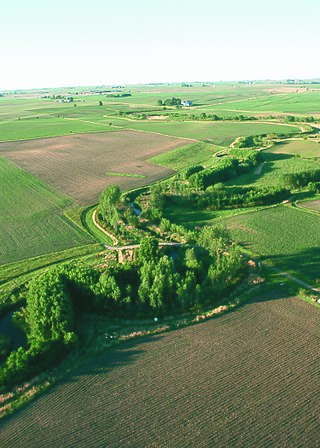
Conservation biology is the study of the conservation of nature and of Earth's biodiversity with the aim of protecting species, their habitats, and ecosystems from excessive rates of extinction and the erosion of biotic interactions. It is an interdisciplinary subject drawing on natural and social sciences, and the practice of natural resource management.

Habitat conservation is a management practice that seeks to conserve, protect and restore habitats and prevent species extinction, fragmentation or reduction in range. It is a priority of many groups that cannot be easily characterized in terms of any one ideology.
Adaptive management, also known as adaptive resource management or adaptive environmental assessment and management, is a structured, iterative process of robust decision making in the face of uncertainty, with an aim to reducing uncertainty over time via system monitoring. In this way, decision making simultaneously meets one or more resource management objectives and, either passively or actively, accrues information needed to improve future management. Adaptive management is a tool which should be used not only to change a system, but also to learn about the system. Because adaptive management is based on a learning process, it improves long-run management outcomes. The challenge in using the adaptive management approach lies in finding the correct balance between gaining knowledge to improve management in the future and achieving the best short-term outcome based on current knowledge. This approach has more recently been employed in implementing international development programs.

Environmental resource management is the management of the interaction and impact of human societies on the environment. It is not, as the phrase might suggest, the management of the environment itself. Environmental resources management aims to ensure that ecosystem services are protected and maintained for future human generations, and also maintain ecosystem integrity through considering ethical, economic, and scientific (ecological) variables. Environmental resource management tries to identify factors affected by conflicts that rise between meeting needs and protecting resources. It is thus linked to environmental protection, sustainability, integrated landscape management, natural resource management, fisheries management, forest management, and wildlife management, and others.

Ecological restoration is the process of assisting the recovery of an ecosystem that has been degraded, damaged, or destroyed. It is distinct from conservation and preservation in that it is an "attempt to co-design nature with nonhuman collaborators." Ecological restoration can reverse biodiversity loss, combat climate change, and support local economies. The United Nations named 2021-2030 the Decade on Ecosystem Restoration.

Ecosystem services are the many and varied benefits to humans provided by the natural environment and healthy ecosystems. Such ecosystems include, for example, agroecosystems, forest ecosystem, grassland ecosystems, and aquatic ecosystems. These ecosystems, functioning in healthy relationships, offer such things as natural pollination of crops, clean air, extreme weather mitigation, and human mental and physical well-being. Collectively, these benefits are becoming known as ecosystem services, and are often integral to the provision of food, the provisioning of clean drinking water, the decomposition of wastes, and the resilience and productivity of food ecosystems.

Natural resource management (NRM) is the management of natural resources such as land, water, soil, plants and animals, with a particular focus on how management affects the quality of life for both present and future generations (stewardship).

In ecology, resilience is the capacity of an ecosystem to respond to a perturbation or disturbance by resisting damage and recovering quickly. Such perturbations and disturbances can include stochastic events such as fires, flooding, windstorms, insect population explosions, and human activities such as deforestation, fracking of the ground for oil extraction, pesticide sprayed in soil, and the introduction of exotic plant or animal species. Disturbances of sufficient magnitude or duration can profoundly affect an ecosystem and may force an ecosystem to reach a threshold beyond which a different regime of processes and structures predominates. When such thresholds are associated with a critical or bifurcation point, these regime shifts may also be referred to as critical transitions.

DPSIR is a causal framework used to describe the interactions between society and the environment. It seeks to analyze and assess environmental problems by bringing together various scientific disciplines, environmental managers, and stakeholders, and solve them by incorporating sustainable development. First, the indicators are categorized into "drivers" which put "pressures" in the "state" of the system, which in turn results in certain "impacts" that will lead to various "responses" to maintain or recover the system under consideration. It is followed by the organization of available data, and suggestion of procedures to collect missing data for future analysis. Since its formulation in the late 1990s, it has been widely adopted by international organizations for ecosystem-based study in various fields like biodiversity, soil erosion, and groundwater depletion and contamination. In recent times, the framework has been used in combination with other analytical methods and models, to compensate for its shortcomings. It is employed to evaluate environmental changes in ecosystems, identify the social and economic pressures on a system, predict potential challenges and improve management practices. The flexibility and general applicability of the framework make it a resilient tool that can be applied in social, economic, and institutional domains as well.
Ecosystem-based management is an environmental management approach that recognizes the full array of interactions within an ecosystem, including humans, rather than considering single issues, species, or ecosystem services in isolation. It can be applied to studies in the terrestrial and aquatic environments with challenges being attributed to both. In the marine realm, they are highly challenging to quantify due to highly migratory species as well as rapidly changing environmental and anthropogenic factors that can alter the habitat rather quickly. To be able to manage fisheries efficiently and effectively it has become increasingly more pertinent to understand not only the biological aspects of the species being studied, but also the environmental variables they are experiencing. Population abundance and structure, life history traits, competition with other species, where the stock is in the local food web, tidal fluctuations, salinity patterns and anthropogenic influences are among the variables that must be taken into account to fully understand the implementation of a "ecosystem-based management" approach. Interest in ecosystem-based management in the marine realm has developed more recently, in response to increasing recognition of the declining state of fisheries and ocean ecosystems. However, due to a lack of a clear definition and the diversity involved with the environment, the implementation has been lagging. In freshwater lake ecosystems, it has been shown that ecosystem-based habitat management is more effective for enhancing fish populations than management alternatives.
Community-based management (CBM) is a bottom up approach of organization which can be facilitated by an upper government or NGO structure but it aims for local stakeholder participation in the planning, research, development, management and policy making for a community as a whole. The decentralization of managing tactics enables local people to deal with the unique social, political and ecological problems their community might face and find solutions ideal to their situation. Overwhelming national or local economic, political and social pressures can affect the efficiency of CBM as well as its long term application. CBM varies across spatial and temporal scales to reflect the ever-changing distinctive physical and/or human environment it is acting within. While the specifics of each practice might differ, existing research maintains that community based management, when implemented properly, is incredibly beneficial not only for the health of the environment, but also for the well-being of the stakeholders.
Akure Forest Reserve is a protected area in southwest Nigeria, covering 66 km2 (25 sq mi). The Akure Forest Reserve, established in 1948 and spanning approximately 32 hectares, was created with the primary aim of safeguarding the genetic diversity of the forest ecosystem.
Population, health, and the environment (PHE) is an approach to human development that integrates family planning and health with conservation efforts to seek synergistic successes for greater conservation and human welfare outcomes than single sector approaches. There is a deep relationship between population, health and environment. Those subjects are not only related to each other but also to other important aspects that are very necessary for keeping PHE in a close-knit relationship.

Forest restoration is defined as “actions to re-instate ecological processes, which accelerate recovery of forest structure, ecological functioning and biodiversity levels towards those typical of climax forest” i.e. the end-stage of natural forest succession. Climax forests are relatively stable ecosystems that have developed the maximum biomass, structural complexity and species diversity that are possible within the limits imposed by climate and soil and without continued disturbance from humans. Climax forest is therefore the target ecosystem, which defines the ultimate aim of forest restoration. Since climate is a major factor that determines climax forest composition, global climate change may result in changing restoration aims. Additionally, the potential impacts of climate change on restoration goals must be taken into account, as changes in temperature and precipitation patterns may alter the composition and distribution of climax forests.

Participatory monitoring is the regular collection of measurements or other kinds of data (monitoring), usually of natural resources and biodiversity, undertaken by local residents of the monitored area, who rely on local natural resources and thus have more local knowledge of those resources. Those involved usually live in communities with considerable social cohesion, where they regularly cooperate on shared projects.

Nature-based solutions (NBS) is the sustainable management and use of natural features and processes to tackle socio-environmental issues. These issues include climate change, water security, water pollution, food security, human health, biodiversity loss, and disaster risk management. The European Commission's definition of NBS states that these solutions are "inspired and supported by nature, which are cost-effective, simultaneously provide environmental, social and economic benefits and help build resilience. Such solutions bring more, and more diverse, nature and natural features and processes into cities, landscapes, and seascapes, through locally adapted, resource-efficient and systemic interventions". In 2020, the EC definition was updated to further emphasise that "Nature-based solutions must benefit biodiversity and support the delivery of a range of ecosystem services." Through the use of NBS healthy, resilient, and diverse ecosystems can provide solutions for the benefit of both societies and overall biodiversity.
The Landscape Conservation Cooperatives (LCC), established in 2009 in the United States, are a network of 22 regional conservation bodies covering the entire United States and adjacent areas. They are autonomous cooperatives sponsored by the U.S. Department of the Interior and aim to develop coordinated conservation strategies applicable to large areas of land. Partnerships are formed with government and non-government conservation organizations to achieve common goals of conservation. While fairly new as government supported entities, the LCCs are similar to initiatives that have been started or advocated in other countries.
Community Based Mangrove Management (CBMM) is a sustainable approach for conserving the rapidly disappearing mangrove forests. It can be defined as community driven management and rehabilitation of mangrove forests involving resource users in the management process directly. CBMM decentralizes authority and power from government to local communities. The dual aim of CBMM is the ongoing conservation of mangroves and generation of sustainable livelihood.

In Nigeria, firewood is a traditional source of energy for domestic and commercial use. Fuel wood is derived from cutting and burning wood materials such as logs and twigs. It has long been prevalent among rural and sometimes urban dwellers.




















